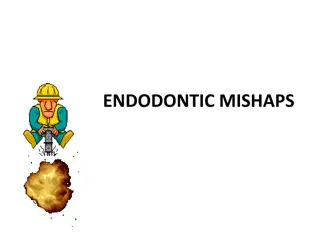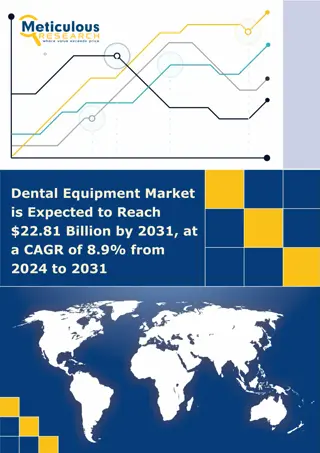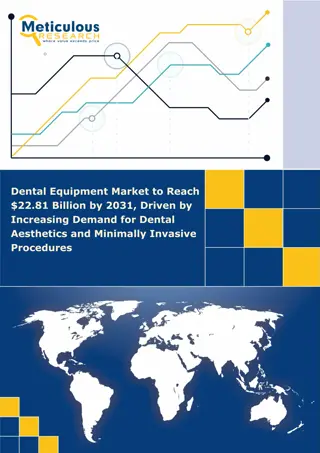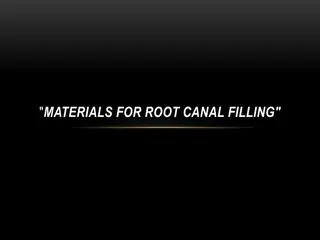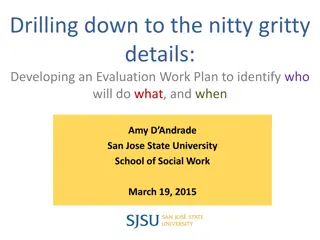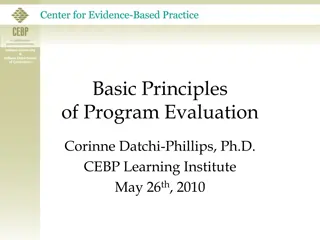Evaluation of Success in Endodontic Treatment
Endodontic treatment success is crucial for patient well-being. Various criteria, including clinical, radiographic, and histological, are used to assess outcomes. Clinical signs like absence of pain and normal tooth mobility indicate successful treatment. Radiographic criteria involve checking for normal ligament space and canal obturation. Histological criteria focus on tissue repair and absence of inflammation. Achieving these benchmarks is vital in determining the effectiveness of endodontic therapy.
Download Presentation

Please find below an Image/Link to download the presentation.
The content on the website is provided AS IS for your information and personal use only. It may not be sold, licensed, or shared on other websites without obtaining consent from the author.If you encounter any issues during the download, it is possible that the publisher has removed the file from their server.
You are allowed to download the files provided on this website for personal or commercial use, subject to the condition that they are used lawfully. All files are the property of their respective owners.
The content on the website is provided AS IS for your information and personal use only. It may not be sold, licensed, or shared on other websites without obtaining consent from the author.
E N D
Presentation Transcript
Endodontic failure and re-treatment . . .
Success is defined by goals Success is defined by goals established to be achieved established to be achieved
The The goal goal of to to prevent prevent or of endodontic endodontic therapy or heal heal the therapy is the disease disease. . is Endodontic treatment outcomes Endodontic treatment outcomes should be defined in reference to should be defined in reference to healing and disease. healing and disease.
Evaluation of success of endodontic treatment Clinical criteria Radiographic Criteria Histological Criteria Evaluation the success or failure of endodontic treatment could be evaluated by combination of various criteria
Clinical criteria for success Absence of PAIN not confirm the absence of disease. NO tenderness to percussion or palpation evidence of subjective discomfort. sign of infection or swelling. sinus tract or integrated periodontal disease
Clinical criteria for success Normal . Normal tooth mobility .Tooth having normal form, function and aesthetics Minimal to no scarring or discoloration
Radiographic Criteria for Success of Endodontic Treatment .Normal or slightly thickened periodontal ligament space .Reduction or elimination of previous rarefaction . No evidence of resorptions X . Normal lamina Dura . A dense three dimensional obturation of canal space
Histological Criteria for Success . Absence of inflammation . Regeneration of periodontal ligament fibers . Presence of osseous repair . Repair of cementum . Absence of resorption . Repair of previously resorbed areas.
Factors Affecting Success or Failure of Endodontic Therapy in Every Case: . Diagnosis and the treatment planning . Radiographic interpretation . Anatomy of the tooth and root canal system . Asepsis of treatment regimen
Factors Affecting Success or Failure of Endodontic Therapy in Every Case: . Quality and extend of apical seal . Quality of post endodontic restoration . Systemic health of the patient . Skill of the operator
Factors Affecting success or Failure of a Particular case . pulp status . Periodontal status . Size of periapical radiolucency . Canal anatomy like degree of canal calcification, presence of accessory or lateral canals, resorption, degree of curvature of canal etc.
Factors Affecting success or Failure of a Particular case . Iatrogenic errors . Crown and root fracture . Extend and quality of the obturation . Quality of the post endodontic restoration . Time of post treatment evaluation.
Case Selection for Endodontic Retreatment Retreatment is usually indicated in symptomatic endodontically treated tooth or in asymptomatic teeth with improper done. 1. Careful history of patient should be taken to know the nature of case, pathogenesis and urgency of the treatment etc. 2. Evaluate the anatomy of root canal in relation to canal curvature, calcifications, un usual configurations etc. 3. Evaluate the quality of obturation of primary endodontic treatment. 4. Check for iatrogenic complications like separated instruments, ledge, perforations, zipping, canal blockages etc. 5. Consider the cooperation of the patient which is mandatory for retreatment procedure
Factors Affecting Prognosis of Endodontic Treatment . Presence of any periapical radiolucency . Quality of obturation . Apical extension of the obturation material . Bacterial status of the canal . Observation period . Iatrogenic complication
Contraindication of Endodontic Retreatment Contraindication of Endodontic Retreatment . . remaining dentine thickness). . . Insufficient crown/root ratio Unfavorable root anatomy (shape, taper, . . Presence of untreatable root resorptions or perforations . . Presence of root or bifurcation caries
STEPS OF RETREATMENT STEPS OF RETREATMENT 1- Coronal disassembly 2-Establish access to root canal system 3- Remove canal obstruction 4- Establish patency 5- Thorough cleaning, shaping, and obturation of the canal
Coronal Disassembly Coronal Disassembly Endodontic retreatment procedures commonly require removal of the existing coronal restoration, but in some cases access can be made through existing restoration.
Coronal Disassembly Coronal Disassembly Gaining access through original restoration helps in: . Facilitate rubber dam placement . Maintaining form, function and aesthetics . Reducing the cost of replacement
But disadvantage of retaining a restoration include: . Reduce visibility and accessibility . Increase risks of irreparable errors . Increase risks of microbial infection if crown margins are poorly adapted.
disadvantage of retaining a restoration include . It is advisable to remove the existing restoration especially if it has poor marginal adaptation, secondary caries to avoid procedural function and aesthetics, temporary crown can be placed. errors. To maintain form,
Established Access to RC system Some teeth post and core which need to be removed to have access opening to RC system Or can be perforated : access can be made through the core without disturbing the post.
Post can be removed by - Used ultrasonic device to loosen the post - Forceful removal of post (risk of fracture) - Removing post by special pliers (post removal systems (PRS) - Or access made through the core without disturbing the post.
Post removal system (PRS) Should have straight line access and post can be easily seen PRS: consist from: 1- 5 trephines (saw) 2- corresponding taps. 3- torque bar. 4- trans-meatal bur 5- rubber bumpers 6- extracting pliers
Initially a transmeatal bur is used for efficiently dooming of the post head.
Then a drop of lubricant such as RC Prep is placed on the post head to further facilitate the machining process.
After that select the largest trephine to engage the post and to machine down the coronal 2-3 mm of the post
Followed by a PRS microtubular tap is inserted against the post head and screwed it into post with counter clockwise direction. Before doing this rubber bumper is inserted on the tap to act as cushion against forces.
tap tightly engages the post, rubber bumper is pushed down to the occlusal surface Mount the post removal plier on tubular tap by holding it firmly with one hand and engaging it with other hand by turning screw knob clocking if post is strongly bonded in the canal, then ultrasonic instrument is vibrated on the tap or a torque bar is inserted onto the handle to increase the leverage, thereby facilitating its removal
Difficulty of Gutta-Percha removal depend on: Length Diameter Curvature Root canal system Don t remove GP in progressively to prevent extrusion of GP. Coronal portion of GP should be removed first by Gates Glidden. 1- removal of GP quickly 2- provide space for solvent 3- improve convenience form
Gutta-Percha can be removed by: a. Using solvents b. Using hand instruments c. Using rotary instruments d. Using microdebrider
A- Using solvents Gutta-percha is soluble in Chloroform Methyl-chloroform Benzene Xylene Eucalyptol oil Halothane Rectified white turpentine, Chloroform is most effective so commonly used. but at high concentrations, it has shown to be carcinogenic, its excessive filling in pulp chamber is avoided.
B- Using of hand instruments: Hand instruments are mainly used in apical portion of the canal. Poorly condensed gutta-percha can be easily pulled out by using of files. Hedstoem files are used to engage the cones so that they can be pulled out in single piece. Removal of gutta-percha can also be done by using hot endodontic instrument like file or reamer. Reamers or files can be used to bypass the gutta-percha sometimes. With over extruded cones, files sometimes have to be extended periapically to avoid separation of the cone at the apical foremen. Sometimes cones that separated at apex may not be retrieved
C- using rotary instrumentation Rotary instruments are safe to be used in straight canals. ProTaper universal system was introduced consisting of D1, D2 and D3 to be used at 500-700 rpm.
D-Using microdebrideres These are small files constructed with 90 degrees bends and are used to remove any remaining gutta-percha on the side of the canal walls or isthmuses after the preparation.
Pastes and Cements Soft setting cement Can be removed using endodontic instruments in crown down technique. Hard setting cements (resin cements) 1- first softened using solvents like xylene, eucalyptol etc. and then removed using endodontic files. 2- Ultrasonic endodontic devices can also be used to breakdown the pastes by vibrations and thus facilitate their removal. 3- Hard setting pastes can also be drilled out using long shank, small round bur.
Separated Instruments and Foreign Objects The primary requirement for removal is their accessibility and visibility. If root canal obstructed by foreign object in coronal third then attempt retrieval. In middle third, attempt retrieval or bypass. In apical third leave or surgically treated.
The removing of broken instruments in coronal and middle third need removal of coronal tooth structure to gain access to the instrument. If over preparation of canal compromises the dentin thickness, one should leave the instrument in place. If instrument is accessible, remove it by using instruments like Stieglitz pliers and Massermann extractor. Massermann extractor consist of a tube with a constriction that grasp the fracture instrument.
Ultrasonics can also be used to remove the instruments by their vibration effect. Broken instruments can also be removed using modified Gates Gladden bur By creating a staging platform before using an ultrasonic tip to rotate around the file in counterclockwise direction to remove it. When it is not possible to remove the foreign objects, attempts should be made to bypass the object and complete biomechanical preparation of the canal. May be during the procedure the instrument will remove.





